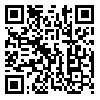BibTeX | RIS | EndNote | Medlars | ProCite | Reference Manager | RefWorks
Send citation to:
URL: http://journal.nkums.ac.ir/article-1-371-en.html
Abstract Background & Objectives: One of the ways to control nosocomial infection is to identify the disease transmission tool, and to determine the infection transmitted through the tool. The aim of this study was to determine the prevalence, type and severity laryngoscope pollution blades for 4 months in treatment wards of Musabne Jafar (AS) hospital Quchan in 2000. Material & Methods: This was a descriptive study in which 104 laryngoscope blades were randomly selected from all the blades disinfected during the four months. Sampling was done with sterile swab samples. In case of bacterial growth and production of colonies, slide preparation and the type of bacteria and bacterial growth was studied. Statistical data were analyzed by SPSS 17 software and used descriptive statistical tests. Results: The results show that the 52.9% (n=55) was infected. Most types of microbial contamination associated with coagulase negative staphylococcus strains with 36.4% (n=20) and the least polluting type associated with enterococci 9.1% (n=5). Comparing the intensity of the treatment units showed the most is relevant to the operating room and the lowest in pediatrics and surgery in men. Conclusion: General principles and methods are common in washing and disinfecting the laryngoscope blades that are acceptable. But the observance of detail and fastidious cleaning and disinfection procedures by the people in different sectors are not approved and not verifiable, that requires more training and the committee of infection control must strict.
Received: 2015/03/28 | Accepted: 2015/03/28 | Published: 2015/03/28
| Rights and permissions | |
 |
This work is licensed under a Creative Commons Attribution-NonCommercial 4.0 International License. |





